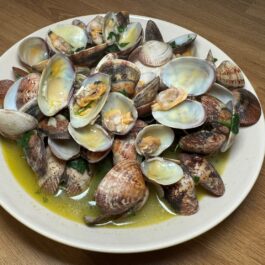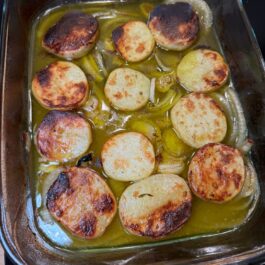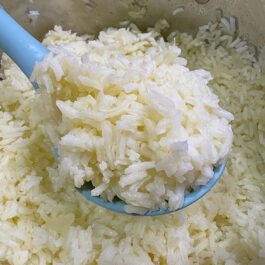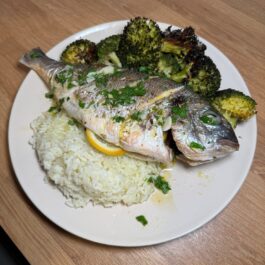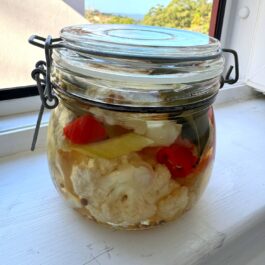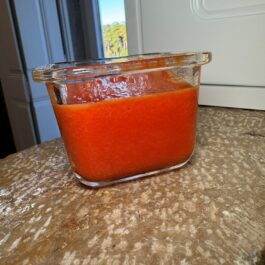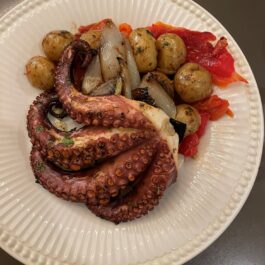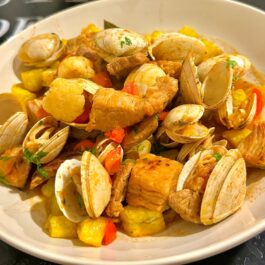Steamed Clams in Garlic White Wine Sauce (Bulhao Pato)
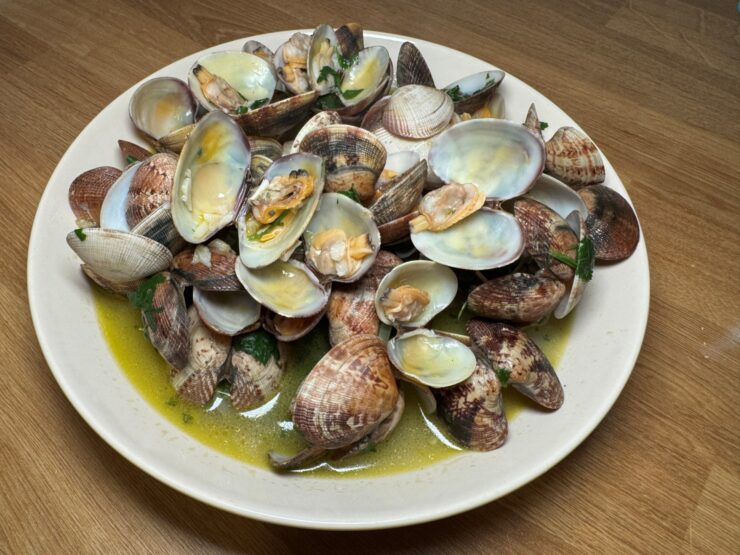
A Classic Portuguese Seafood Appetizer
Bulhão Pato, steamed clams in a garlic white wine sauce, is a traditional Portuguese dish named after the 19th-century poet Raimundo António de Bulhão Pato, who was an admirer of its simplicity and elegance. This dish, often served as an appetizer or light meal, highlights fresh clams cooked in a fragrant, garlicky sauce. Its hallmark flavors come from a harmonious blend of olive oil, garlic, white wine, and fresh cilantro, all of which enhance the natural brininess of the clams. The dish’s origins lie in Portugal’s coastal regions, where seafood reigns supreme.
Steamed Clams Portuguese Style > Bulhao Pato: Big Flavor, Surprisingly Simple Preparation
The preparation is straightforward, making it an accessible recipe for home cooks and an ideal dish to showcase quality ingredients. Fresh clams are thoroughly cleaned to remove sand and grit before being simmered in a sauce made by sautéing garlic in olive oil and deglazing with white wine. A generous sprinkle of chopped cilantro gives the dish a distinctive aroma and a vibrant touch of color. Lemon wedges are often served on the side, allowing diners to add a splash of tanginess to balance the richness of the sauce.
Which Clam to Use:
Here’s a breakdown of the differences between littleneck clams, cockles, ameijoa preta, and ameijoa branca:
1. Littleneck Clams (Mercenaria mercenaria)
- Origin: Found along the eastern coast of North America.
- Size: Small, typically about 1 to 2 inches in diameter.
- Shell: Hard, ridged, and grayish-white in color.
- Flavor & Texture: Mildly sweet and briny with a firm, chewy texture.
- Common Uses: Often served raw on the half-shell, steamed, or used in pasta and chowders.
2. Cockles (Family Cardiidae)
- Origin: Found in Europe and Asia, commonly harvested in Portugal, the UK, and New Zealand.
- Size: Small, around 1 inch across.
- Shell: Distinctly ribbed and heart-shaped when viewed from the side.
- Flavor & Texture: Sweeter than clams, with a softer, more delicate texture.
- Common Uses: Popular in Portuguese and Spanish cuisine, often cooked in garlic and white wine sauces, or simply steamed.
3. Ameijoa Preta (Venerupis corrugata)
- Origin: Native to the coastal waters of Portugal and Spain.
- Size: Medium, around 1.5 to 3 inches.
- Shell: Elongated with dark streaks or spots, giving it a “black” (preta) appearance.
- Flavor & Texture: Stronger briny taste with a firm, slightly chewy texture.
- Common Uses: Used in traditional Portuguese dishes like “Amêijoas à Bulhão Pato” and seafood stews.
4. Ameijoa Branca (Venerupis decussata)
- Origin: Also found in Portugal and the Mediterranean.
- Size: Similar to Ameijoa Preta, around 2 to 3 inches.
- Shell: Lighter in color, often beige or pale brown with a smoother surface.
- Flavor & Texture: Milder and slightly sweeter than Ameijoa Preta, but still firm.
- Common Uses: Ideal for steaming, adding to rice dishes, and classic Portuguese clam recipes.
Key Differences:
- Littleneck clams are more commonly eaten raw, while Portuguese varieties are often cooked in garlic and wine.
- Littleneck clams are from North America, while the others are native to Europe.
- Cockles are sweeter and have a distinct heart-shaped shell.
- Ameijoa Preta is darker and more briny, whereas Ameijoa Branca is milder and paler.
Try clams with the famous pork of Alentejo > Carne Alentejana Porco Preto
Grab Some Bread and Enjoy!
Traditionally, Bulhão Pato is enjoyed with crusty bread, perfect for soaking up the flavorful broth. It is a versatile dish that pairs wonderfully with a crisp white wine, such as a Vinho Verde or Albariño. Whether served at a summer gathering or as part of a festive spread, Bulhão Pato captures the essence of Portuguese coastal cuisine—simple, fresh, and deeply satisfying.
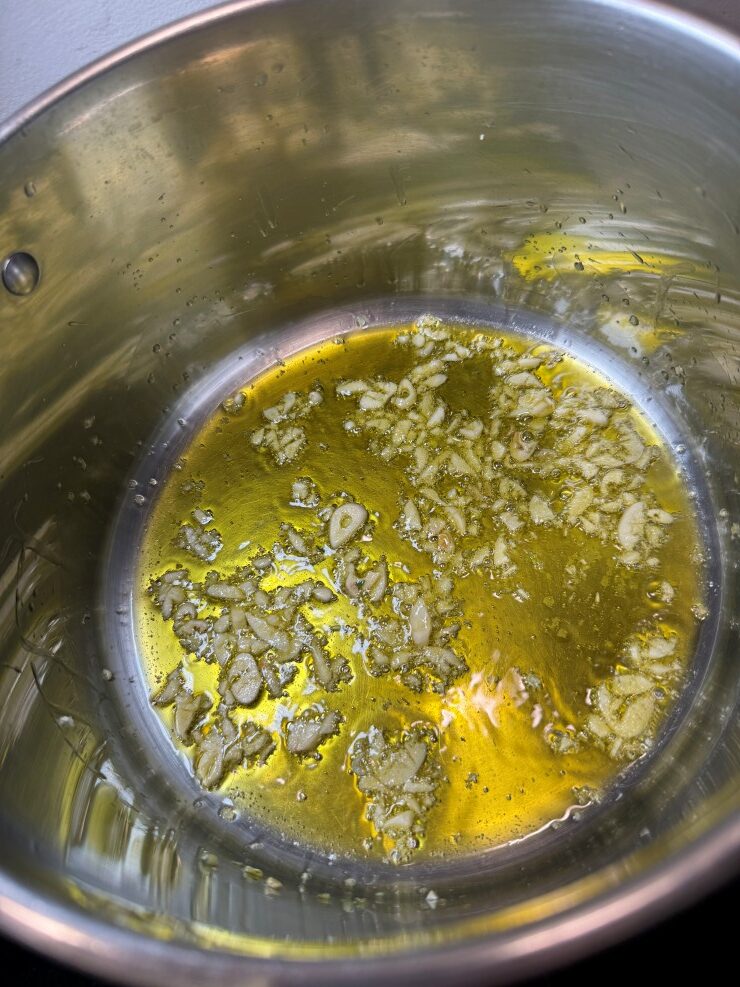
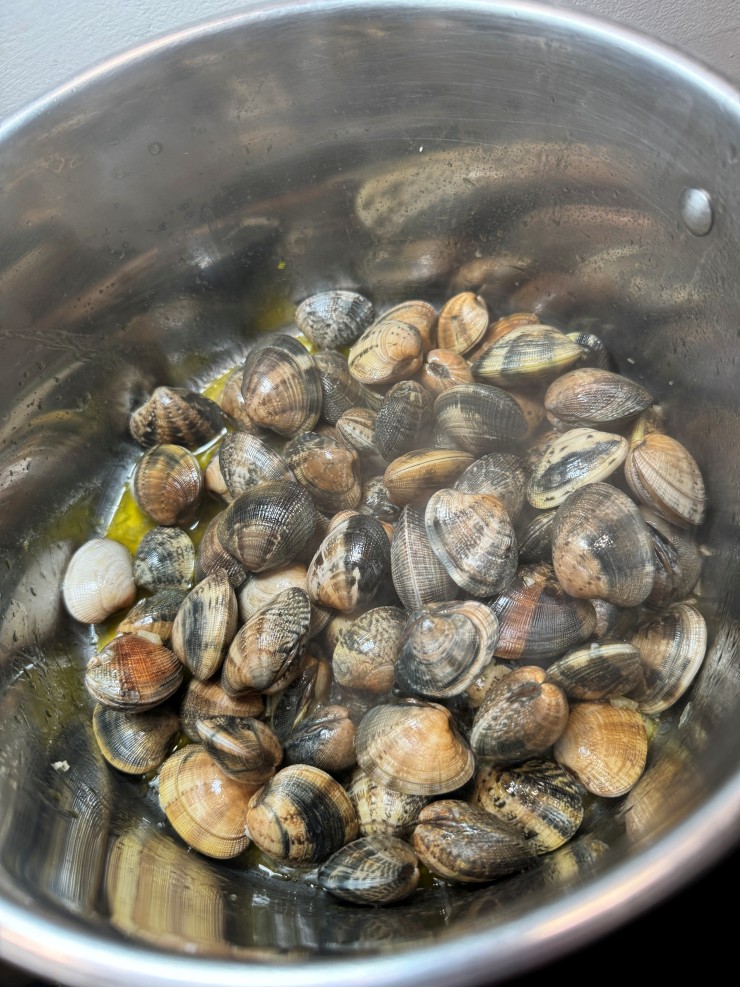
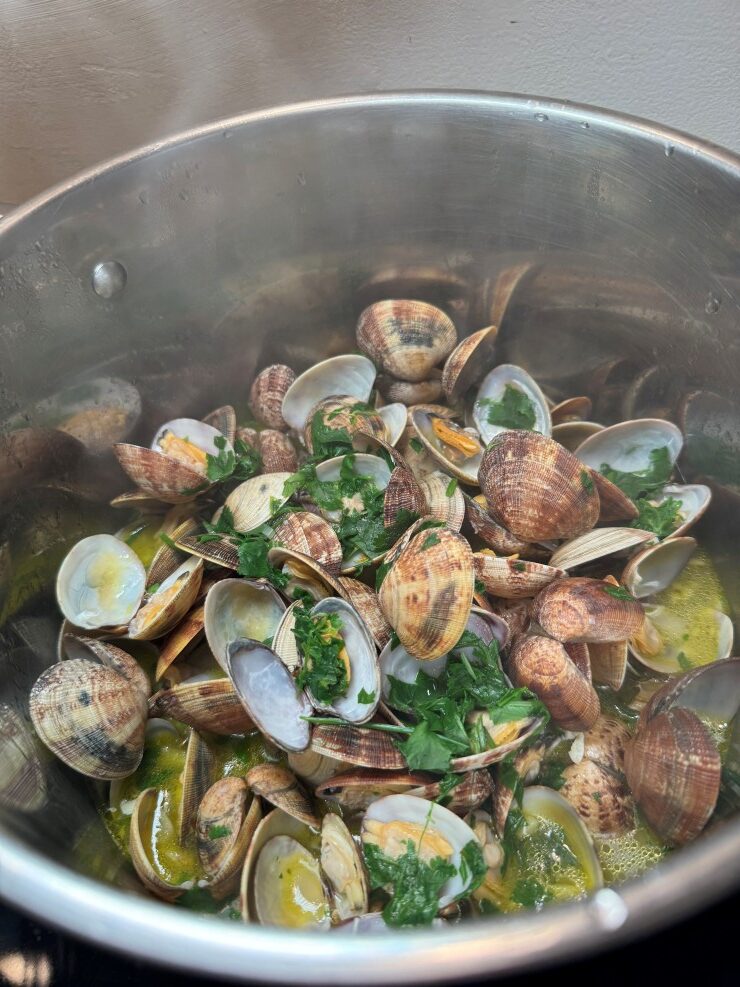
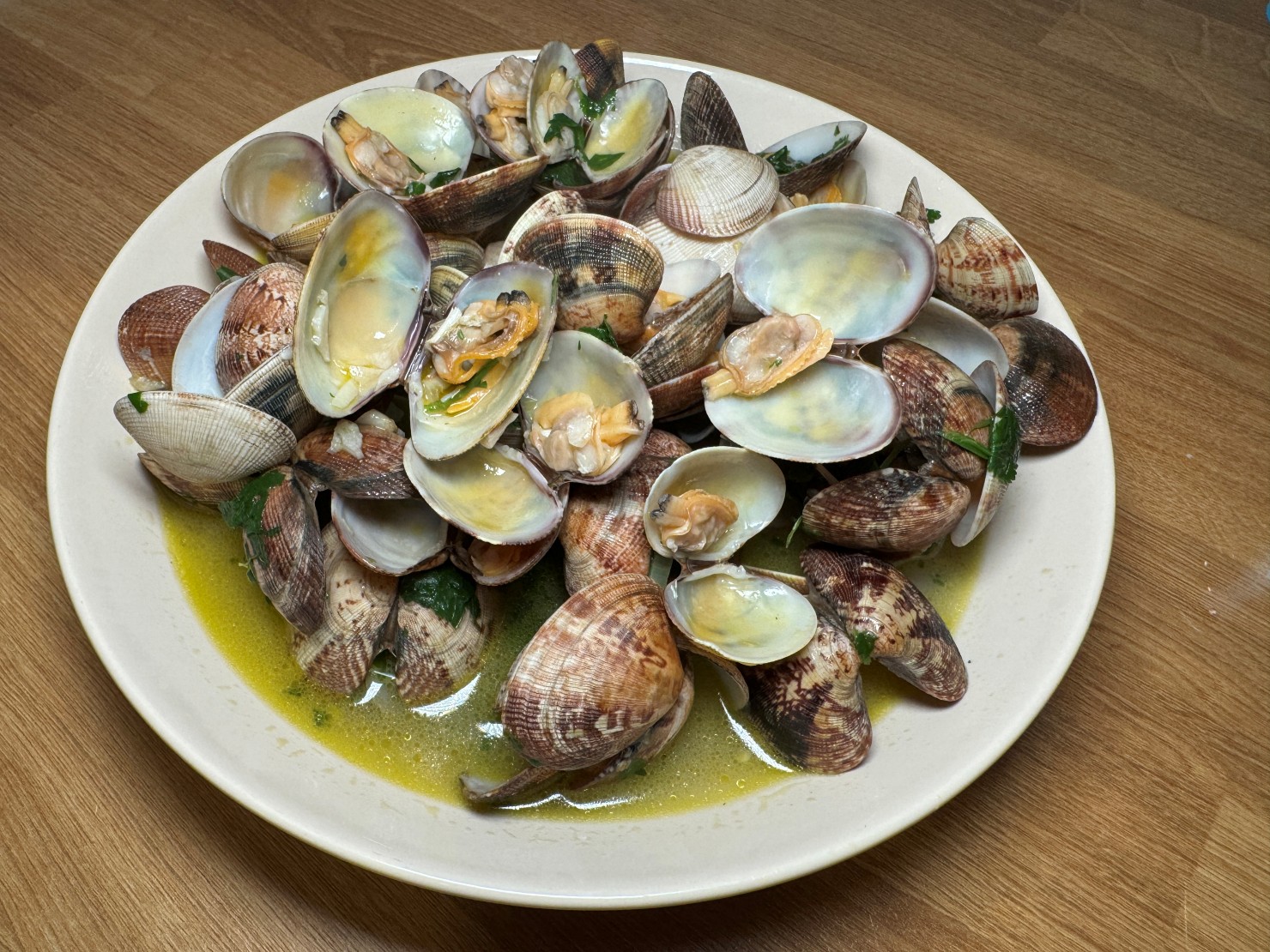
Portuguese Steamed Clams: Bulhao Pato
Ingredients
- 2 lbs clams, littleneck clams, cockles, ameijoa preta, or ameijoa branca: see note above about clams
- 4 garlic cloves, thinly sliced
- 2 tbsp olive oil, enough to cover the pot or pan with a thin layer
- 1/2 cup white wine, dry white wine such as sauvignon blanc or alvarinho
- 1 leaves from a small bunch of cilantro, rough chop
- 1-2 tbsp kosher salt, 1 tablespoon for cleaning the clams and additional to taste
Equipment
- 1 medium pot or deep saute pan with a lid
Instructions
- In a large bowl add a tablespoon of kosher salt and fill 3/4 full with cold water.
- Rinse the clams under cold water in the sink to remove surface sand.
- Place the clams in the bowl of salt water for at least 30 minutes. They will purge sand during this time.
- After the 30 minutes, drain the clams with a strainer.
- In the pot or pan, add olive oil and heat over medium heat.
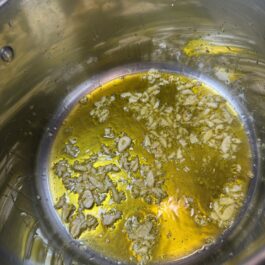 Once the oil is hot, add the garlic. Season with a pinch of salt.
Once the oil is hot, add the garlic. Season with a pinch of salt.- Cook the garlic for 2 minutes, moving around with a spatula. The goal is soft garlic, not browned garlic, so modify the temperature as needed.
- Add the white wine, stir and increase the heat to high.
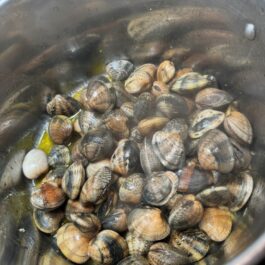 Once boiling add the clams and cover with a lid.
Once boiling add the clams and cover with a lid.- Cook for 5 minutes or until all of the clams open, up to 10 minutes depending on the type of clam.
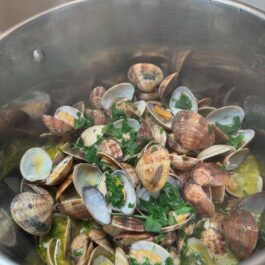 Once the clams have opened, toss in the cilantro and stir with a spatula to combine.
Once the clams have opened, toss in the cilantro and stir with a spatula to combine.- Serve the clams in bowls, spooning the broth over the clams.
- Optional, serve with a toasted buttered baguette to dip in the leftover broth.
